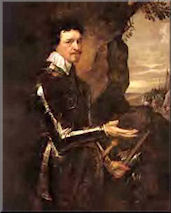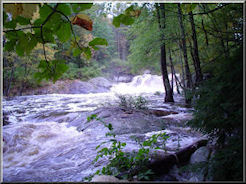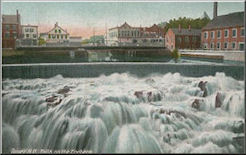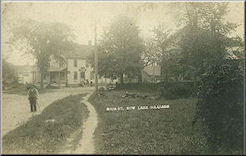First Settlements
The first English settlement was established in the region along the
Piscataqua River in 1623. From 1643 to 1680, New Hampshire was actually
a province of Massachusetts, and the boundary between them was not
really settled until 1740.

Thomas Wentworth, First Earl of Strafford
Strafford inherits its name from the county Strafford, whose name dates
back to the
Earl of Strafford of England, titles owned by the Wentworth family
(chiefly Thomas and his heirs) going back to 1640. Strafford, VT also
owes its name origin to this family. The Strafford name was also adapted
by a Dover-based state militia called the
Strafford Guards, who escorted the wealthy statesman and soldier the
Marquis de Lafayette of France on his visit to the States.
Barrington, first incorporated in 1722, originally was comprised of all
the land in Strafford that would eventually become an independent
township much later in 1820. Although Strafford was settled much
earlier, it later became incorporated because of the lengthy travel
distance for town meetings in Barrington. The whole region - but
especially the Strafford area - was attractive to very early colonists
because of its virgin timber. Indeed lumbering would be the main
occupation of the majority of people that came to live there in the
early days. Most of the streams in the area at one time or another had
mills erected on them, and the chief purpose of them at that time was
solely for lumber.

Bow Pond Stream
Later to be known as the Isinglass River, the Bow Pond Stream was one of
the very first in the area to have a mill built in or around 1766.
Another one built a little further north was known as the "Upper Boopon"
mill. Back then, the water power was mainly its strongest in the spring,
and most of the mills then were known as "day mills" or "share mills"
mostly because the shareholders had operational rights to them on a
temporary basis, sometimes for just a few days or less a month.
The Bow Pond Sawmill
Another mill was erected on Bow Pond Stream and in 1783 was sold to
Nathaniel Foss, and that farm also was one of the first in the area to
also have a grist mill. Previously, there really were not enough people
in the area to have need of a grist mill. The lower Bow Pond sawmill and
the land around it, previously owned by Ebenezer Demeritt of Madbury,
eventually was sold to James Tuttle who operated it as a day mill. Then
again, the majority of shares was eventually sold in the early 1820's to
the Dover Manufacturing Company.
 Originally
incorporated in 1812 as the Dover Cotton Company, it was eventually sold
to the
Cocheco Manufacturing Company in 1829. Photo to the left is Cocheco
Falls in Dover, circa 1910. From then all the way up to the Wall Street
Crash in 1929, it was a leader in textile production (chiefly cotton
prints or calicos) along with mills southward In Lawrence and Lowell
Massachusetts. In early 1823, the Dover Manufacturing Company erected a
dam on Bow Pond. Shares in the saw mill, as well as the land around it
and flowage rights, were then purchased by property owners around Bow
Pond.
Originally
incorporated in 1812 as the Dover Cotton Company, it was eventually sold
to the
Cocheco Manufacturing Company in 1829. Photo to the left is Cocheco
Falls in Dover, circa 1910. From then all the way up to the Wall Street
Crash in 1929, it was a leader in textile production (chiefly cotton
prints or calicos) along with mills southward In Lawrence and Lowell
Massachusetts. In early 1823, the Dover Manufacturing Company erected a
dam on Bow Pond. Shares in the saw mill, as well as the land around it
and flowage rights, were then purchased by property owners around Bow
Pond.

Bow Lake Village, Grange Hall
In between in 1829, a steam-operated mill was erected in Bow Lake
Village. See photo circa 1912 to the right. This steam-operated mill was
later to become the Bow Lake Grange Hall, now maintained by the
Bow Lake Community
Club and home to
Lakeside
Players. Just three years after the Cocheco Manufacturing Company
owned the property, disaster struck. At 4:00 AM on March 14, 1832 the
dam broke. All of the mills along the river as well as many of the
buildings in town were destroyed by the flooding. Large granite blocks
were dug from the area, and building a better dam was soon underway.
More flowage rights were obtained, and gave employment to many men in
the area. Eventually in 1909 the Cocheco Manufacturing Company sold all
of this to the Pacific Mills of Lawrence, MA. Shortly after, Lawrence in
1912 was the scene of the
Bread and Roses Strike, one of greatest labor actions in American
history. It started when mill owners increased the speed of factory
looms, and then lowered wages for thousands of women and child workers.
Later what Cocheco purchased was sold to the city of Dover itself.
Modern Times
It was then eventually sold to the Public Service Company of New
Hampshire and then to the State of NH itself in 1962. All rights then
were now under the management of the Water Resources Board, patrolling
the lake and caring for the dam and gates. Bow Lake is 5 square
kilometers in area, 2.8 miles at its longest point and 1.2 miles at its
widest.